
Technology and innovation have propelled humanity forward, allowing us to travel around the world and beyond, talk to friends and family from far away, and live longer than ever before. These conveniences, however, come with a cost. As we’ve spread and traveled throughout the world, our carbon footprint has skyrocketed, threatening our planet’s delicate atmospheric balance and increasing global temperatures.
In this episode, we journeyed to northern peat bogs to meet a tiny plant that could have big implications in our fight against climate change. Peat bogs are vast wetlands whose soft, spongy ground is composed largely of living and decaying Sphagnum moss. The waterlogged conditions and low pH prevent dead plant material from fully decomposing. This means that all of the carbon stored within the plant material is locked inside the bogs instead of being released into the atmosphere.
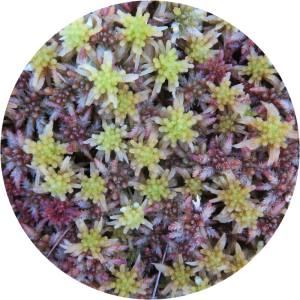
Peat bogs store an incredible amount of our terrestrial carbon. Although they make up only about three percent of the earth’s landmass, peat bogs hold more than 30 percent of the earth’s carbon. When peat bogs are drained or disturbed by direct human intervention or climate warming, the carbon stored for centuries is released into the atmosphere, contributing to global warming. This is why understanding and preserving peat bogs is so important in our fight against climate change.
The health of Sphagnum mosses is crucial to maintain peat bogs as a carbon sink and avoid them becoming carbon sources. Join us for Tiny Expeditions Season 4, Episode 3, “Moss to the rescue: peat bogs and the fight against climate change,” as we learn how scientists are using genetic technology to better understand the dynamics of Sphagnum mosses amidst a warming climate.
Behind the Scenes
For all the Season 2 fans, this episode was made for you! That’s right, we journeyed back into the botanical world. Plants are the basis of all life on Earth, providing us with everything from the nutrients we need to thrive to paper and other products to life-saving medicines. However, overutilizing the very plants that we so heavily rely on is part of a vicious feedback circle that is damaging our climate.
Through the process of photosynthesis, plants absorb carbon dioxide from the air and release oxygen, which is essential for us to breathe. CO2 is stored within the plant until it dies and decomposes. Then the carbon is released back into the atmosphere.
Over-harvesting plants and trees without replacing them takes away their ability to turn CO2 into oxygen and releases stored carbon into the atmosphere. Manufacturing, packaging, and transporting goods also add to our net carbon footprint.
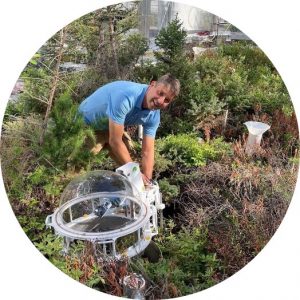
In this episode, we specifically focused on how a tiny moss called Sphagnum stores massive amounts of carbon under the soil in the form of peat. Human activities, including harvesting peat for gardening and energy, threaten to release all of the stored carbon and wreak havoc on the atmosphere. Luckily, researchers like our three guests are studying various aspects of Sphagnum moss biology to understand how we might protect the bogs and ensure they remain the mighty carbon sinks there are.
We were so excited to talk with Dr. Dave Weston, a staff scientist at the Oak Ridge National Laboratory who also works on the SPRUCE project. Like Dr. Weston explained in the episode, SPRUCE stands for Spruce and Peatland Responses Under Changing Environments. The experimental station is located in a Sphagnum bog forest in northern Minnesota, about 40 km north of Grand Rapids, in the USDA Forest Service Marcell Experimental Forest. The area is in a region of our country considered especially vulnerable to climate change.
The SPRUCE enclosures Dr. Weston described in the episode are pictured below. Five of the enclosures are maintained to reflect the outside temperature, humidity, and CO2 levels. The five experimental enclosures each represent various “climate futures” with increasing temperature and CO2 levels. The team at SPRUCE is measuring pretty much everything in the enclosures, including ecological responses for trees, shrubs, bryophytes, microbial communities, and whole-ecosystem processes. This means looking at everything from visual observations of plant health, snow and ice levels each year, microbes living in and around the mosses, peat depth, amount of CO2 and methane released from the bogs, and much more.
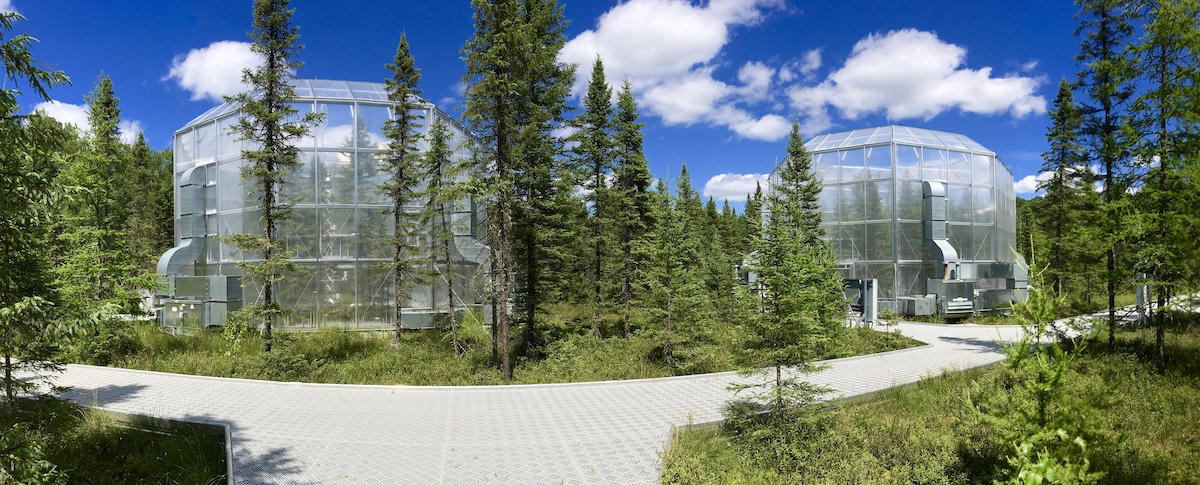
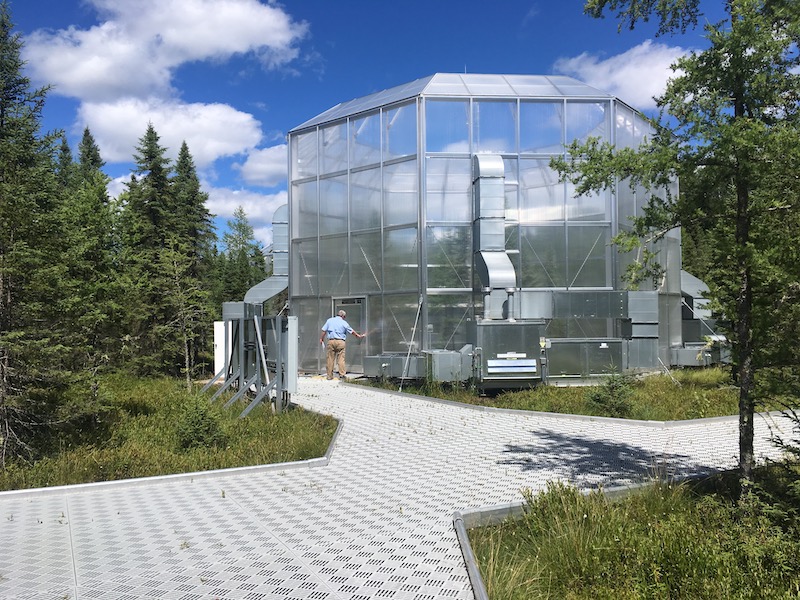
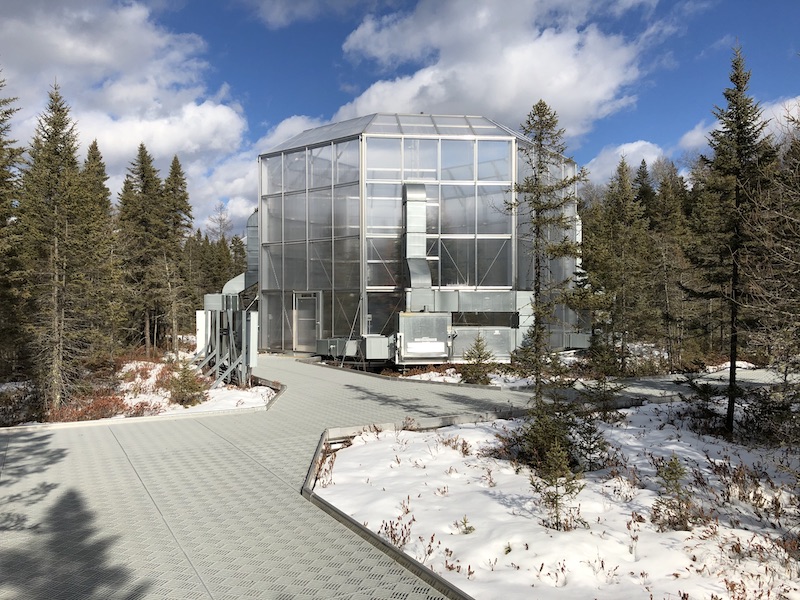
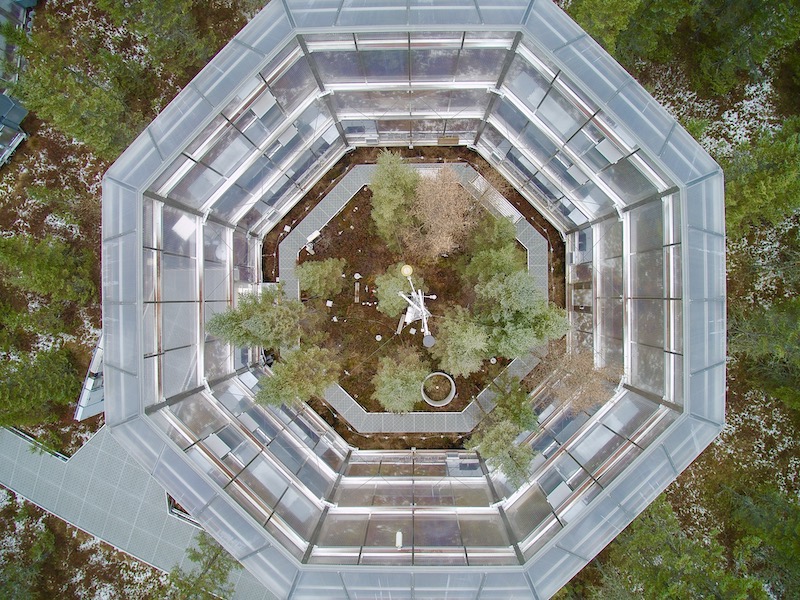
Our two other guests, Jeremy Schmutz and Dr. Adam Healey, are helping study the bog’s health in a different way by creating genomic resources Sphagnum researchers can use to look at the mosses at a genomic level. To help understand the genetic basis for Sphagnum carbon sequestration and ecosystem engineering, they produced high-quality reference genomes for two Sphagnum species.
Reference genomes are essential in plant biology as they provide a high-quality and comprehensive framework for understanding the genetic makeup of a species. These genomes serve as a reference point for researchers to compare and analyze the DNA of different plants, helping to identify genes responsible for traits such as disease resistance, yield, and quality. Schmutz, Healey, and the rest of their team at the HudsonAlpha Genome Sequencing Center are experts at creating high-quality reference genomes.
The Sphagnum reference genome provided the team with information that could be useful in the continued quest to understand peat bog carbon sequestration. Male and female mosses respond differently to different stress cues like changing temperature and changing pH. Using this information when repopulating Sphagnum species into diminishing peat bogs could help scientists create communities of mosses that have the best chance of adapting to our changing climate. There is still much to understand about the future of Sphagnum mosses and peat bogs amidst our warming climate, but researchers like our three guests are at the forefront of discovery.


Chris Powell 00:02
Welcome to Season Four, episode three of Tiny Expeditions.
Sarah Sharman 00:05
I’m Dr. Sarah Sharman, here to help you understand the science.
Chris Powell 00:08
And my name is Chris Powell. I’ll be your storytelling guide for this episode.
Sarah Sharman 00:16
We promised you that in this season, we would cover some of the many ways DNA technology is impacting our future. This means the future for all of us, but it also includes our planet.
Chris Powell 00:26
In today’s expedition, we’ll learn about a tiny plant with big impact on our environment. But first, let’s talk about climate change.
News clips 00:39
According to a new United Nations report, the devastating impacts of human-caused climate change are happening now. The darkest warning yet, not only about what could happen, but what’s already been set in motion. Emissions of house gases need to peak within the next three years, if we’re to stave off the worst effects of climate change. And even then, we’d still need new technology to suck carbon dioxide out of the skies by the middle of the century.
Chris Powell 01:10
Talking about climate change can be scary. And it’s important for us to be able to differentiate between what is fact and what is fiction. In order to do that, we need to first figure out, well, how did we get to where we are now? Throughout history, technology and innovation have propelled us into new places—we’ve gone across the oceans, we’ve gone across the continental United States, and even into space. However, as we spread and traveled throughout the world, our carbon footprint has also traveled with us, and with this, CO2 levels have risen exponentially.
Sarah Sharman 01:43
So why is this such a big deal? When carbon dioxide or CO2 is released into the atmosphere, it creates sort of an insulating blanket. A little bit of CO2 is great to maintain the ambient temperature we need to survive, but too much traps excess heat, raising the temperature on our planet. Thankfully, nature has given us a way to combat this.
Jeremy Schmutz 02:02
Carbon cycling is this idea that organisms metabolize and they take up carbon.
Chris Powell 02:08
That’s the voice of Jeremy Schmutz, faculty investigator at the HudsonAlpha Institute for Biotechnology.
Jeremy Schmutz 02:13
They use that carbon for life. And then they do things like release gases. In the case of plants, they also accumulate biomass, and then that biomass is left behind afterward. And so, what happens is plants sequester the carbon, and then they leave it behind. So that happens most commonly, if you think about trees, for example, which you know, leave these, these sort of big trunks behind them. And then those big trunks are like concentrated carbon. And then, as humans, we do things like chop the trees down, use them to grow things or to burn them and turn them back into carbon dioxide.
Sarah Sharman 02:48
Our superstar plant for this episode, sphagnum moss, can store carbon for hundreds of thousands of years. If you’re into gardening, you may recognize the name from your potting mix. When sphagnum is alive, it is a vibrant green and red color. And it lives in peat bogs.
Jeremy Schmutz 03:02
Sphagnum works to alter its environment. One of the reasons for that is that it lives in the bog, and the bog is like, sometimes wet and sometimes dry. And there’s like low lying parts, which is called hollows. And then there’s parts that are called hammocks, which are kind of the bumps that come out of there. And different sphagnum species have kind of specialized and so there’s this radiation almost between hammock to hollow. And so, some of them live in water most of the year, other than when it’s cold or frozen. And some of them live kind of in the dry. And then there’s this lawn species that kind of goes from the top of the hills down into the bogs on the bottom. And each one of those have specialized, we’re talking about, you know, looking at hundreds of millions of years evolution, they specialized into these sort of different niches along there. And so, they will do things like modify the pH of the soils. So, as these plants grow and die and reproduce, then their materials get left behind. And it doesn’t degrade because very few microbes can survive, and you need those microbes and fungi to be able to break down material from the plants. So that’s one of the reasons why the peat bogs were able to grow and continue to have this super dense carbon content in them is because they didn’t allow bacteria and fungi to get in there and to eat it and break it down like you would if you were talking about like a normal terrestrial plant where it dropped the leaves and the leaves would get digested in into leaf matter by lots of things. And so, sort of the pH these bogs really prevents that from occurring.
Chris Powell 04:40
Peat bogs are a dynamic ecosystem. But unless you live in the northern part of the United States, in the UK, or Russia, you probably haven’t seen one.
Dave Weston 04:48
So, a peat bog is a type of wetland.
Sarah Sharman 04:52
That’s the voice of our second guest, Dave Weston, a staff scientist at the Oak Ridge National Laboratory.
Dave Weston 04:57
When you enter one of these peat bogs it’s a very spongy ground. And it’s spongy because it’s composed of a bunch of dead organic material, largely plant material. And of that plant material, most of it is composed of these sphagnum mosses. And then after it degrades, and it becomes that spongy material I was talking about, that’s known as peat. And this is the stuff that is mined, and you buy this in your garden center or scotch distilleries use this to make their scotch and put that particular peaty flavor in there, and it’s used as a heating source in Europe for many years. So, it’s a very unique ecosystem. It’s an absolutely beautiful ecosystem to visit. But also important from an economic perspective but from our interests from a carbon cycling perspective, it’s extremely important. Peatlands themselves, or I should say peat bogs in particular, if you look at the total land area on Earth, they’re only about 3%. So, they occupy a relatively small amount of land area on a global scale, yet they contain about 30% of all the soil carbon in that dead organic peat I was talking about.
Chris Powell 06:09
It is amazing that peat bogs store 30% of our terrestrial carbon. That’s great news as long as the carbon stays in the bog.
Jeremy Schmutz 06:17
And so, the concern is that with temperature changes and warming, that will then start reducing the sequestration that is going on, and then potentially turning into a net CO2 release coming from these peat bogs. And then that can start the cycle where that then increases the temperature of the planet because you’re adding greenhouse gases in the environment. And then that continues to drive the release of the carbon from these peat bogs. And right now where we are with carbon, or in this case, carbon in the atmosphere, so we want to keep it all in the ground, if at all possible, whether that’s, you know, pumping more oil, and using more oil, we want to keep that in the ground, or we want to keep in the natural systems around because this is a huge amount of carbon that could potentially come out and be released into the environment in the atmosphere. If these sphagnum get pushed so far that they can’t do what they’re doing now, which is this ecosystem engineering to try to maintain the store of carbon underground there.
Sarah Sharman 07:20
It’s difficult to really envision how quickly plants will be affected by our changing climate without exposing them to extreme conditions. And that’s exactly what Dr. Weston and his colleagues at SPRUCE are trying to do.
Dave Weston 07:31
The acronym SPRUCE actually stands for the Spruce and Peatland Responses Under Changing Environments. And it’s a large Department of Energy-supported project that is on US Forest Service property. And this project, essentially, is a whole ecosystem warming experiment. So, there are these 10 very large enclosures, 12 meters in diameter, so 36 feet or so in diameter, and, and these enclosures have a bit of an open top on them. And we have 10 of them and think of them in two sets of five. And so, in the first set of five, you have what we call an ambient control condition, meaning it’s not adding any extra CO2 or elevated temperature to it, it’s just sort of tracking what’s on the outside and maintaining that. And there might be a slight warming in that case, just from indirect solar irradiance. And then, it steps up in smaller increments until you get to the plus nine. And so, in that case, it’s adding almost 17 degrees Fahrenheit or so of temperature in addition to what the outside temperature is. And it’s doing that both above ground through forced air, as well as below ground through below-ground warming. And then, between those two, you have three other enclosures now that have that stepwise changes in those warming scenarios. And so, you would have five of those that would have what we call our ambient or natural CO2 condition. And then you would have another one that’s at about double that or so. So, it’s about 900 ppm CO2. And so, it’s asking the question, if you double the atmospheric CO2 concentration, you know, and you have this warming response surface, what’s going on? So it’s a massive project, something that I encourage your listeners to look up online if they get a chance.
Sarah Sharman 09:41
The different SPRUCE chambers basically represent different climate futures. The scientists are taking many different measurements to assess how the plants and bogs are reacting to the changes. So naturally, Chris and I were curious about what the most extreme spruce chamber looked like.
Dave Weston 09:54
As far as a visual context, it’s really dramatic. So, you can see, you know, I haven’t been up to Minnesota in a few months, but there’s still snow on the ground at this site, but you would see in the plus nine, you would see the leaf green up and emergence coming out well before those in that ambient chamber. So, you would see that and then in the middle of the season, particularly in a drought year, like we had two years ago, you can just see, it looks pretty horrible in those really elevated enclosures looks pretty brown and nasty in there. And then of course, the big finding that was recently published with Paul Hanson was that these mosses are declining. I should say Rich Norby published that. We have these mosses declining with warming, and it seems to be linear. And then from that, Paul Hanson’s finding a correlation that that’s actually changing the amount of carbon that’s in the soil, and it’s actually been emitted as CO2 and methane into the atmosphere. So, it’s a bit worrisome. Those projections,
Chris Powell 11:07
SPRUCE is one project to look at the impact of climate change on peat bogs, but one project will not give us a total understanding of Sphagnum moss and peat bogs. That’s when we have to take multiple approaches, like looking at the whole ecosystem, studying the microbial communities in the bog, and looking at the genetics of Sphagnum moss. In order to study the genetics, scientists needed a reference genome.
Adam Healey 11:29
So, when we create a reference genome,
Chris Powell 11:32
That’s the voice of Dr. Adam Healey, a computational biologist at the HudsonAlpha Genome Sequencing Center.
Adam Healey 11:37
…particularly in the case of Sphagnum, this involves collaborating first with researchers who know a lot about the plant and go out in the field and select a plant that has interesting biology that we would like to understand further. In Sphagnum’s case, we wanted to understand how sphagnum grows in response to environmental stress within peat bogs. Within peat bogs, Sphagnum tends to grow in mounds and valleys. And this dynamic influences how much carbon they can sequester. So, our two reference genomes that we sequenced reflect those two extremes, one species prefers to grow up on mountains, and the other prefers to grow down in valleys. Now, after selecting a reference, we take it back to the lab, and we grow it under sterile conditions. At that point, staff extracts DNA from plant tissue and prepares a sequencing library, and then runs that sample on a sequencer machine. The sequencer then tells you the individual bases in that organism’s genome in long but fragmented pieces. Then it’s up to computational biologists to put those pieces together in a correct order to build individual chromosomes and use them to better understand the biology of a plant.
Sarah Sharman 12:51
Once the DNA puzzle is sequenced and put back together, scientists can start figuring out what it all means. In the case of the Sphagnum genome, Dr. Healey and his colleagues were in for a few surprises.
Adam Healey 13:01
Early in the analysis of these Sphagnum genomes led to one of those classic aha moments in science, where we found a really odd result, and we followed it down a rabbit hole and found some pretty amazing results. So first, when we sequenced these two reference genomes, we noticed that there was an extra bit of sequence that we couldn’t place it didn’t really fit anywhere. We first thought that perhaps we made a mistake. It wasn’t until we looked at our second reference genome that we saw the same piece of sequence was unanchored again. So, for this reason, we started to look at it more closely. It was this tiny piece of DNA about a quarter of the size of other chromosomes in the genome. And it had some really unique characteristics to it. It was far more repetitive than other chromosomes, and it had far fewer genes on it. And it actually turns out that this piece of sequence was actually the sex chromosome inside them. And it’s one of the smallest sex chromosomes ever observed in plants so far.
Sarah Sharman 13:58
Sex chromosomes are a pair of chromosomes that determine the biological sex of an organism. We inherit one sex chromosome from mom and one from dad. In the case of humans, along with most placental mammals, and some insects, snakes, fish, and plants, we have an XY chromosome system with an X and a Y chromosome. X, X is a biological female, and XY is a biological male. Sex chromosomes can play a role in some human diseases. And in plants, sex chromosomes can confer beneficial traits, like better-tasting valuable fruits or even certain climate adaptations.
Adam Healey 14:30
What’s really interesting about the sex chromosome comes into play in understanding how Sphagnum responds to environmental stress. Peat bogs are famously harsh places for plants to live. They’re very acidic. In an experimental population of Sphagnum, where we were trying to understand how Sphagnum contends with this acidic stress, researchers at the Oak Ridge National Lab exposed plants to both neutral and acidic conditions to see how their growth changes. We found that the sex chromosome played a significant role in that response. So female plants responded predictably across the population when exposed to acidic stress. Their growth was all impacted in a similar way. Males, however, showed two separate responses. Some responded more favorably to acidic stress or were more negatively impacted under neutral conditions, whereas other males had the exact opposite response. So, it’s only once you have a reference genome that you can start to find fine-grain patterns in your data like this. Without a reference sequence, we wouldn’t know which plants are actually male and female. And these differences in responses would be lost. They would effectively cancel each other out. This enables us to pinpoint why there are differences in how males and females respond to different stress cues and peat bogs, which will allow us to better protect these ecosystems that are crucial to our global carbon cycle.
Chris Powell 15:58
The challenge of climate change affects us all. And it’s a challenge that doesn’t have a single simple answer. The consequences of climate change are very real and can be scary to think about. While there’s reason to be concerned, there’s also reason for hope.
Dave Weston 16:13
It certainly makes you pause and wonder, do we really realize you know, kind of what we’re doing to the environment, you know, as stewards of this earth? But at the same time, I tend to be somewhat optimistic. And I feel like humans in general, we’ve sort of evolved to the point where we’re really good at using a lot of resources when it is right in front of us. But we’re also pretty good at conserving those once we realize that they’re limiting. And so, I’m hoping that’ll be the case. And then another reason for hope is kind of like the research that I was talking about that was supported by DOE and JGI and others. We’re showing that you can have some of these beneficial interactions happening that we didn’t otherwise know were happening. And perhaps we can understand those a little bit better. And that might help us just a little bit in making these ecosystems more resilient to climate change.
Sarah Sharman 17:20
Thank you for joining us for this tiny expedition. We hope you appreciate the importance of peat bogs in our fight against climate change.
Chris Powell 17:27
Next episode, we’ll talk about how science is preparing us for future novel pandemics.
Sarah Sharman 17:31
Tiny Expeditions is a podcast about genetics, DNA, and inheritance from the HudsonAlpha Institute for Biotechnology. We’re a nonprofit research institution in Huntsville, Alabama.
Chris Powell 17:41
We’ve got a campus full of scientists doing public research alongside companies developing products and services, all with one aim to translate genomic discoveries into real-world applications and make for a healthier, more sustainable world. That includes everything from cancer research to agriculture for changing climate.
Sarah Sharman 17:58
If you find this podcast interesting, rate, review, like, and subscribe on the podcast app of your choice. And tell someone that you listen to this interesting little story about genetics. Knowledge is better when you share it.
Chris Powell 18:09
Thanks for joining us.






